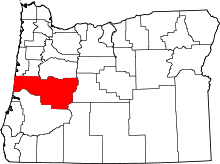McCredie Springs, Oregon
| McCredie Springs | |
|---|---|
| Unincorporated community | |
|
McCredie Springs Resort and sawmill in 1910 | |
 McCredie Springs Location within the state of Oregon | |
| Coordinates: 43°42′35″N 122°17′20″W / 43.70972°N 122.28889°WCoordinates: 43°42′35″N 122°17′20″W / 43.70972°N 122.28889°W | |
| Country | United States |
| State | Oregon |
| County | Lane |
| Elevation | 2,064 ft (629 m) |
| Time zone | Pacific (PST) (UTC-8) |
| • Summer (DST) | PDT (UTC-7) |
| ZIP code | 97463 |
| Area code(s) | 458 and 541 |
| GNIS feature ID | 114953[1] |
McCredie Springs is an unincorporated community in Lane County, Oregon.[2] It is located near Oregon Route 58, about 10.7 miles (17.2 km) east of Oakridge, and 50.7 miles (81.6 km) east of Eugene. McCredie Springs is within the Willamette National Forest and is known for the nearby natural hot springs.[3]
McCredie Hot Springs
The hot springs are located at 43°42′14″N 122°17′14″W / 43.70389°N 122.28722°W,[4] on the other side of OR 58 from McCredie Springs, by the banks of Salt Creek.
The springs were first discovered by a trapper named Frank Warner who settled near them in 1878. He lived there until the Forest Service was established in 1905 and removed him from his land. In 1911 a developer from Eugene, John Hardin, filed a mineral claim on the land. The mineral claim allowed him to lease land from the Forest Service, and he used that lease to construct a two-story resort hotel in 1914. A baseball player from Portland, William "Judge" McCredie, took over the lease in 1916 and operated the resort as a baseball camp. Although the resort changed ownership several times over the next several decades, the name "McCredie Springs" stuck. During its heyday in the 1930s, the resort was served by five Southern Pacific passenger trains each day.
The hotel burned to the ground in 1958 and a 1964 flood destroyed the bridge that provided access to the springs. The Forest Service cancelled the lease and razed the remaining buildings. Today, the site remains mostly natural.[5]
References
- ↑ "Geographic Names Information System". United States Geological Survey. Retrieved 2008-01-31.
- ↑ "OR HomeTownLocator: McCredie Springs, Oregon".
- ↑ "McCredie Hot Springs". oregonhotsprings.immunenet.com.
- ↑ "McCredie Hot Springs". GNIS.
- ↑ http://oregongiftsofcomfortandjoy.blogspot.com/2011/11/sepia-saturday-102-hotel-mccredie.html

